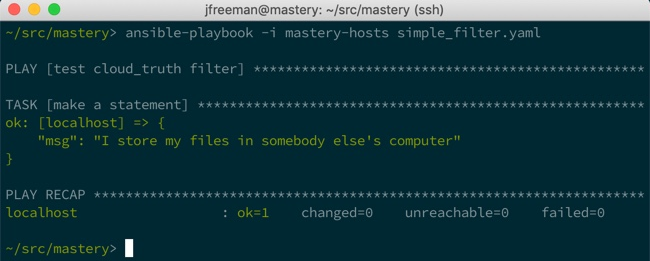While Jinja2 includes a number of filters, Ansible has made filters pluggable to extend the Jinja2 functionality. Ansible includes a number of filters that are useful for Ansible operations, and users of Ansible can add more. Existing plugins can be found in plugins/filter/.
To demonstrate the development of a filter plugin, we will create a simple filter plugin to do a silly thing to text strings. We will create a filter that will replace any occurrence of the words the cloud with the string somebody else's computer. We'll define our filter in a file within a new directory, filter_plugins/, in our existing working directory. The name of the file doesn't matter, as we'll define the name of the filter within the file; so, let's name our file filter_plugins/sample_filter.py.
First, we need to define the function that will perform the translation, and provide the code to translate the strings:
def cloud_truth(a):
return a.replace("the cloud", "somebody else's computer")
Next, we'll need to construct a FilterModule object and define our filter within it. This object is what Ansible will load, and Ansible expects there to be a filters function within the object that returns a set of filter names to functions within the file:
class FilterModule(object):
'''Cloud truth filters'''
def filters(self):
return {'cloud_truth': cloud_truth}
Now we can use this filter in a playbook, which we'll call simple_filter.yaml:
---
- name: test cloud_truth filter
hosts: localhost
gather_facts: false
vars:
statement: "I store my files in the cloud"
tasks:
- name: make a statement
debug:
msg: "{{ statement | cloud_truth }}"
Now, let's run our playbook and see our filter in action:

Our filter worked, and it turned the words the cloud into somebody else's computer. This is a silly example without any error handling, but it clearly demonstrates our capability to extend Ansible and Jinja2's filter capabilities.